Nevada is home to a few species of hummingbirds, which are some of the smallest and most colorful birds in the world. In this post, we’ll explore the different types of hummingbirds found in Nevada, their habitats, behaviors, and conservation status.
From the common and vibrant Rufous Hummingbird to the rare and elusive Black-chinned Hummingbird, we’ll take a closer look at these fascinating birds and their roles in Nevada’s ecosystems. We’ll also provide tips on how to spot and identify these birds in the wild, as well as some resources for further reading and exploration.
Whether you’re an avid birdwatcher, a nature enthusiast, or simply curious about the wildlife in your area, we invite you to join us on a journey to discover the amazing world of hummingbirds in Nevada!
9 Types of Hummingbirds in Nevada
- Anna’s Hummingbird
- Rufous Hummingbird
- Black-Chinned Hummingbird
- Broad-Tailed Hummingbird
- Costa’s Hummingbird
- Calliope Hummingbird
- Broad-Billed Hummingbird
- Allen’s Hummingbird
- Rivoli’s Hummingbird
Ruby-throated Hummingbirds
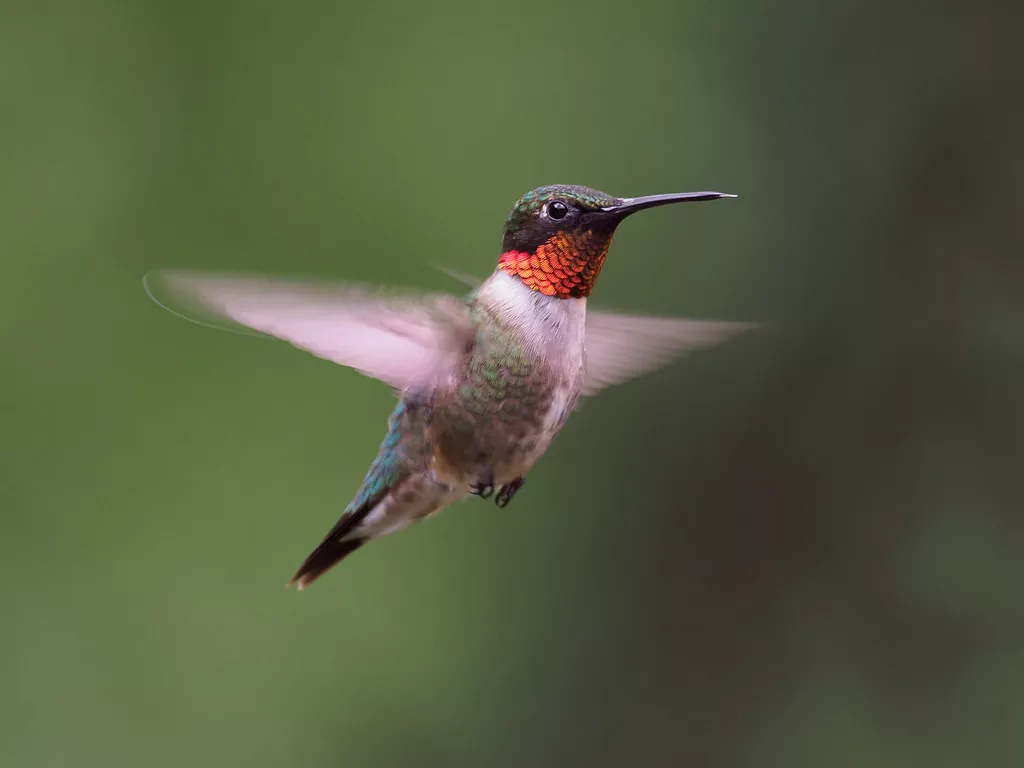
Image Source
- Scientific name: Archilochus colubris
- Lifespan: 3 to 5 years in the wild
- Weight: 2.5 to 4 grams
- Size: 7 to 9 cm (2.8 to 3.5 inches) in length, with a wingspan of 8 to 11 cm (3.1 to 4.3 inches)
- Origin: Found throughout eastern North America, from southern Canada to the Gulf of Mexico, as well as in some parts of Central America during migration.
The male Ruby-throated Hummingbirds have an iridescent red throat, and both sexes have bright green throats and back with gray-white undersides. Female Ruby-throated Hummingbirds have white undersides, greenbacks, and brownish crowns and sides.
The only hummingbird species that breeds in eastern North America is the Ruby-throated Hummingbird, which subsequently migrates farther south to Central America. Some travel across Texas along the coast or over the Gulf of Mexico. For breeding, they begin to arrive in the deep south in February and may not reach the northern states and Canada until May. They go south In September and August.
These little birds fly from one nectar source to another, catching insects in the air or on the webs of spiders. They will sometimes rest on a tiny branch, but because of their short legs, they can only shuffle along a perch and can’t walk.
The best locations to look for them outside in the summer are flowering gardens or forest margins. They are very widespread in urban areas, particularly around nectar feeders.
Male Ruby-throated Hummingbirds are aggressive in the protection of feeders and flowers. After mating, they do not stay around for very long and may migrate by early august.
Ruby-throated females make their nests on thin branches out of thistle or dandelion down that are bound together by spider silk. They lay 1-3 eggs that are only 0.6 inches in diameter (1.3 cm)
Black-chinned Hummingbird
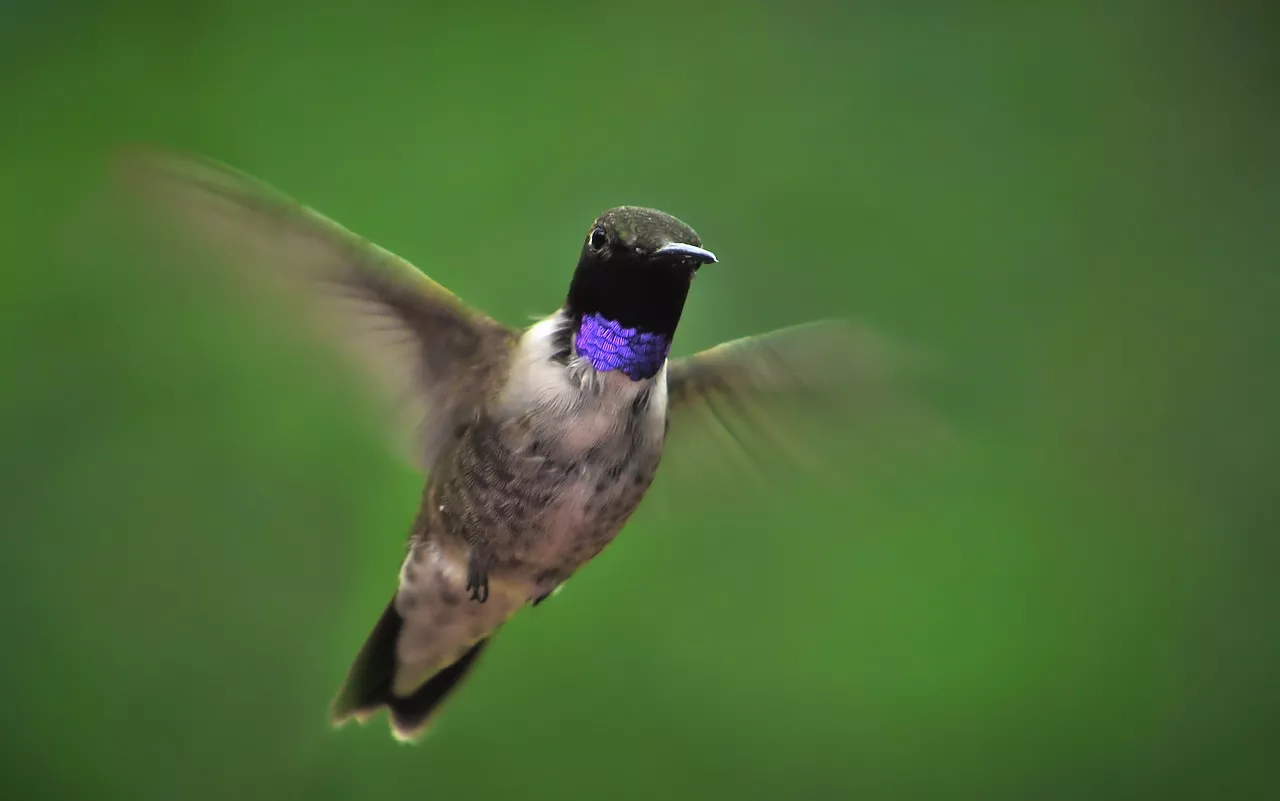
Image Source
- Scientific name: Archilochus alexandri
- Lifespan: Up to 10 years in the wild
- Weight: 3 to 3.5 grams
- Size: 8.5 to 10.5 cm (3.3 to 4.1 inches) in length, with a wingspan of 11 to 13 cm (4.3 to 5.1 inches)
- Origin: Found in western North America, from the western United States to northern Mexico.
Black-chinned Hummingbirds have grayish-white undersides and dull metallic green backs. The females have a light neck and white tail feather tips, while the males have a black throat with a thin, iridescent purple base.
Black-chinned hummingbirds mostly breed inland in western states, and during the winter they travel to western Mexico and the Gulf Coast.
They eat nectar, tiny insects, and spiders. While consuming nectar, their tongues can lick 13–17 times per second.
Black-chinned Hummingbirds lay 2 white, tiny eggs that are barely 0.6 inches long in their nests, which are made of plant down and spider silk to keep them together (1.3 cm)
Black-chinned Hummingbirds often return to a favorite perch and are frequently seen perched at the tops of dead trees on small, bare limbs. They may be found among shaded oaks on the Gulf Coast or by canyons and rivers in the Southwest.
Rufous Hummingbird
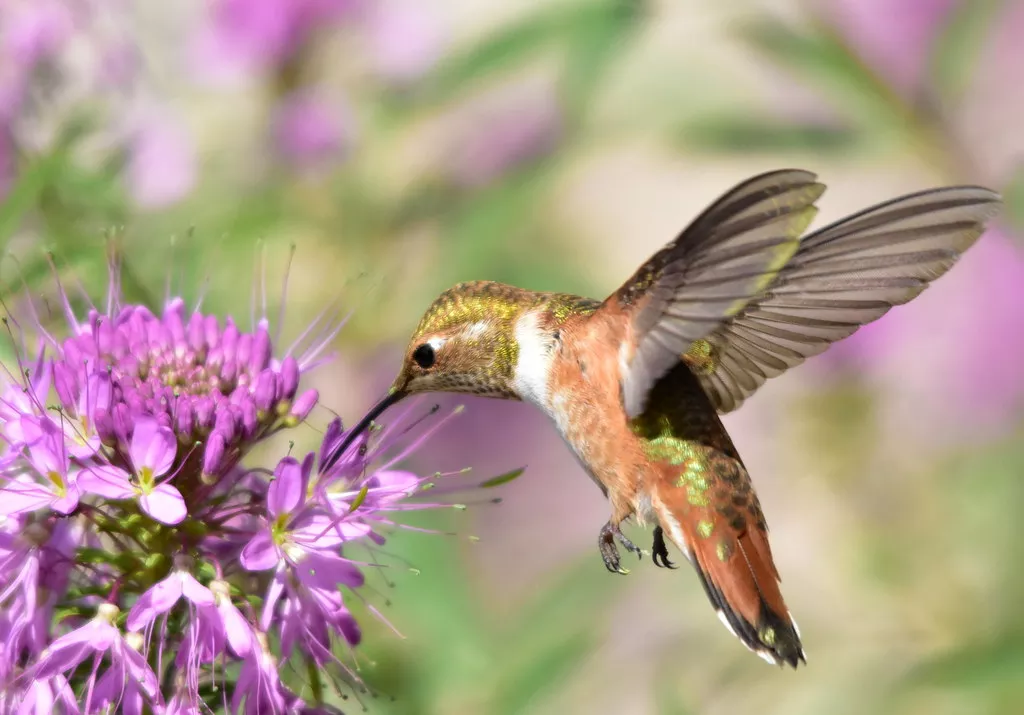
Image Source
- Scientific name: Selasphorus rufus
- Lifespan: 3 to 5 years in the wild
- Weight: 2.7 to 4.3 grams
- Size: 7 to 9 cm (2.8 to 3.5 inches) in length, with a wingspan of 11 cm (4.3 inches)
- Origin: Found in western North America, from Alaska to Mexico
Rufous Hummingbirds are bright orange on the back and belly, have a white patch below the neck, and have an iridescent red throat. The females have a pale belly and a back that is greenish-brown and rusty in color.
As compared to their size, rufous hummingbirds have one of the longest migration routes, covering up to 4000 kilometers on each trip. They move south to Mexico and the Gulf Coast to spend the winter after breeding in northwest Alaska.
In the spring, they go north along the Pacific Coast, and in the late summer and autumn, they pass past the Rocky Mountains.
The main sources of food for rufous hummingbirds are nectar from vibrant tubular flowers and insects including gnats, midges, and flies. As they climb higher into the trees, they utilize spider webs and soft plant down to bind their nest together. They deposit one or two tiny, white, 0.5-inch (1.3-centimeter) eggs.
They are aggressive and will attack any hummingbird, even larger or resident during migration. They’re short-lived during migration and frequently hunt other hummingbirds. Mountain meadows and winter forests are their home.
Anna’s Hummingbirds

Image Source
- Scientific name: Calypte anna
- Lifespan: Up to 10 years in the wild
- Weight: 3.5 to 6 grams
- Size: 9 to 11 cm (3.5 to 4.3 inches) in length, with a wingspan of 12 to 13 cm (4.7 to 5.1 inches)
- Origin: Found on the western coast of North America, from southern Alaska to Baja California
Little Anna’s Hummingbirds are mostly green and grey in color. The female’s neck is grey with spots of red whereas the male’s head and throat are iridescent reddish-pink.
Anna’s Hummingbird is the most common non-migratory hummingbird along the Pacific Coast. The males do a stunning dive performance during mating, climbing as high as 130 feet in the air before plummeting back to the earth while making a loud noise with their tail feathers.
While they may also be found in scrub and savannah, Anna’s hummingbirds prefer the backyards and parks with, vibrant flowers and nectar feeders.
The nests of Anna’s hummingbirds are located high in trees, between 6 and 20 feet above, and they often have two to three broods each year.
Calliope Hummingbird
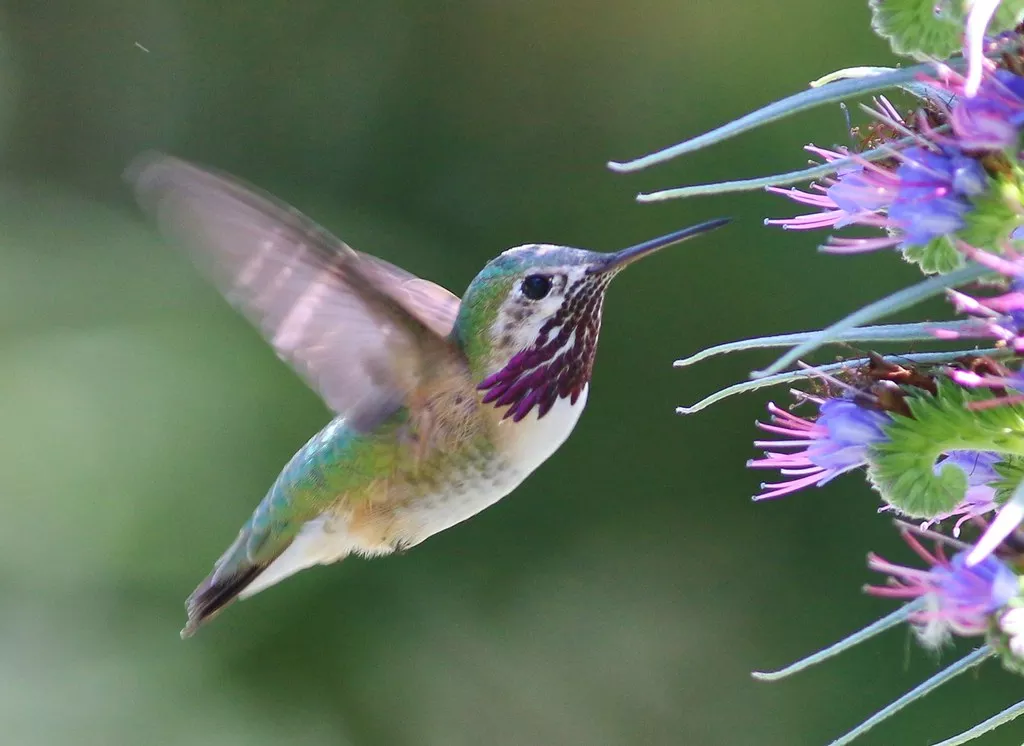
Image Source
- Scientific name: Selasphorus calliope
- Lifespan: 3 to 5 years in the wild
- Weight: 2 to 2.5 grams
- Size: 7 to 8 cm (2.8 to 3.1 inches) in length, with a wingspan of 11 cm (4.3 inches)
- Origin: Found in western North America, from southern Canada to Mexico
The Calliope Hummingbird, the tiniest bird in America with the size of a ping pong ball, travels more than 5000 miles annually from Mexico to Canada and back. Moreover, they fight valiantly to protect their territory and even pursue Red-tailed Hawks.
Male Calliope Hummingbirds have shiny green backs and sides, brilliant magenta throats (known as the gorget), and black tails. The underside of females is more pinkish-white than white, unlike that of males, who have iridescent throats.
They migrate in spring from the Pacific Coast to breeding grounds in California, Colorado, and up to northern states and Canada, They migrate pretty early and arrive between the middle of April and the beginning of May.
Their nests are often found on evergreen trees and may be reused or built over an older nest.
Allen’s Hummingbird
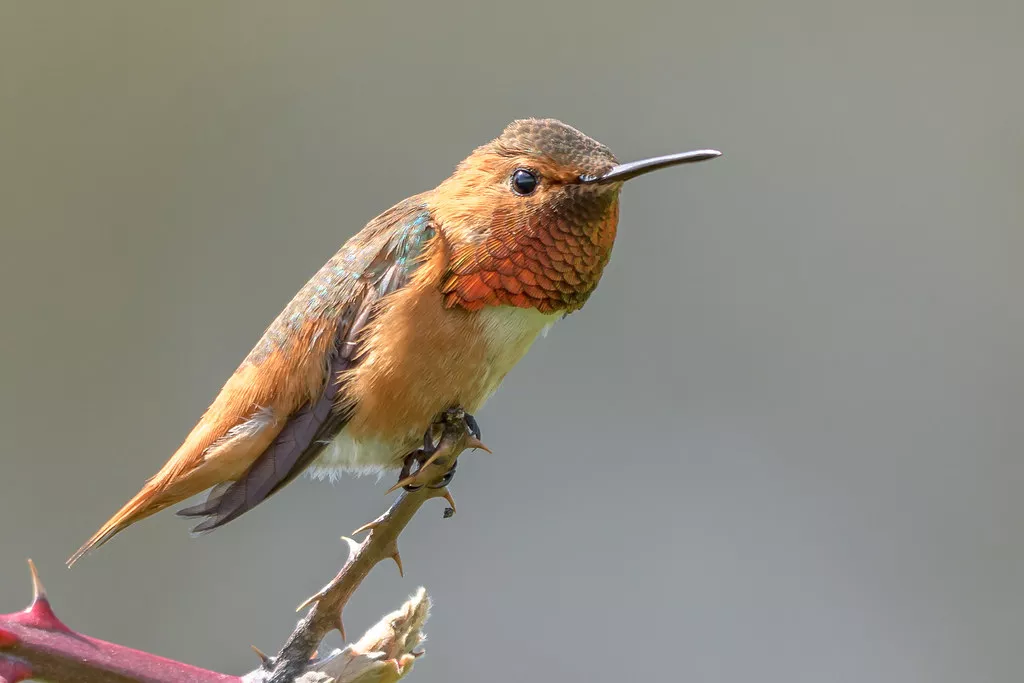
Image Source
- Scientific name: Selasphorus sasin
- Lifespan: 3 to 5 years in the wild
- Weight: 2.5 to 3.5 grams
- Size: 7 to 9 cm (2.8 to 3.5 inches) in length, with a wingspan of 11 cm (4.3 inches)
- Origin: Found in western North America, from Alaska to Mexico
It may be difficult to distinguish Allen’s Hummingbirds from Rufous Hummingbirds in the little area of coastal woodland and scrub between California and Oregon that they inhabit.
Male Allen’s Hummingbirds have orange bellies, tails, and eye patches along with iridescent reddish-orange throats. The females lack the brilliant throat color, but both sexes have long, straight bills and coppery-green backs.
The Allen’s Hummingbird’s small outer tail feathers are what set it apart from Rufous Hummingbirds. They may have up to three broods a year and build nests at no particular height along shaded streams.
Allen’s Hummingbirds move up to the Pacific Coast in California and Oregon as early as January and spend the winter in Mexico. Some continue to live in Los Angeles and central Mexico.
Costa’s Hummingbird

Image Source
- Scientific name: Calypte costae
- Lifespan: Up to 5 years in the wild
- Weight: 3 to 4 grams
- Size: 8 to 10 cm (3.1 to 3.9 inches) in length, with a wingspan of 12 to 13 cm (4.7 to 5.1 inches)
- Origin: Found in the southwestern United States and Mexico, primarily in desert and scrubland habitats.
Costa’s Hummingbirds are mostly desert-dwelling hummingbirds with eye-catching, outward-curving purple neck patches and purple crowns. Their bellies are white with green coloration on the sides, and their backs are green. Female Costa’s Hummingbirds have a more white belly and lack the purple tint.
Baja California, southern California, and southwestern Arizona are home to Costa’s Hummingbirds. Also, throughout the winter, they go between Mexico’s Pacific Coast and Arizona, the southern reaches of Nevada Utah, and California for breeding.
Costa’s Hummingbirds live in desert scrub, chaparral, and deciduous forests, and they frequent a wide variety of plant types. They may have up to two broods a year and build their nests in bushes between three and seven feet from the ground.
Broad-billed Hummingbird

Image Source
- Scientific name: Cynanthus latirostris
- Lifespan: 3 to 5 years in the wild
- Weight: 3 to 4 grams
- Size: 9 to 10 cm (3.5 to 3.9 inches) in length, with a wingspan of 12 cm (4.7 inches)
- Origin: Found in southwestern United States and Mexico
Broad-billed hummingbird has bright colors even among the hummingbirds. The males have a deep metallic green color throughout, and their blue throats reach down to their breasts. Females have light bellies and both males and females have red beaks that are black-tipped and broad toward their heads.
Broad-billed can be found in central Mexico and along the Pacific coast of Mexico throughout the year. Some birds spend the whole year close to the Mexican border, while others travel north to breed in mountain valleys in southern Arizona and New Mexico.
Broad-billed Hummingbirds prefer to forage in canyon streams and alpine meadows, although they will also visit garden feeders. They build their nests around streams at a relatively low height of about 3 feet.
Rivoli’s Hummingbird

Image Source
- Scientific name: Eugenes fulgens
- Lifespan: Up to 8 years in the wild
- Weight: 8 to 11 grams
- Size: 11 to 14 cm (4.3 to 5.5 inches) in length, with a wingspan of 16 to 18 cm (6.3 to 7.1 inches)
- Origin: Found in montane forests of Mexico, Central America, and western Panama.
The Rivoli’s Hummingbird is a huge hummingbird with more striking colors than other hummingbirds because the females have an emerald green iridescent neck, while the males have a purple iridescent crown. The females are whitish beneath and have green backs, while the males are dark green.
While most Rivoli’s Hummingbirds winter in Mexico and Central America, some do move north to southwestern Texas, southern Arizona, and northern New Mexico. They visit feeders throughout their range but are mostly found in pine-oak woods in hilly areas. They build their nests rather high up.
Conclusion
Hummingbirds are a remarkable species that can be found in the state of Nevada. These small, colorful birds are known for their agility and unique behavior, such as their ability to fly backward and hover in mid-air. If you want to attract hummingbirds to your yard in Nevada, consider planting native flowers, using a hummingbird feeder, and keeping your yard free of pesticides. With a little effort, you can create a welcoming environment for these beautiful birds to thrive in. Whether you’re a seasoned birdwatcher or just starting to explore the world of hummingbirds, Nevada is an excellent place to witness these amazing creatures up close. So, next time you’re out exploring nature in Nevada, keep your eyes peeled for these tiny, yet mighty, birds.
Frequently Asked Questions about Hummingbirds in Nevada:
Q: When do hummingbirds arrive in Nevada?
A: Hummingbirds typically arrive in Nevada in late March or early April, although the exact timing can vary depending on the species and weather conditions.
Q: What is the best way to attract hummingbirds to my yard in Nevada?
A: Hummingbirds are attracted to brightly colored flowers and sugar water feeders. Planting flowers such as bee balm, columbine, and cardinal flower can help attract hummingbirds to your yard. You can also fill a hummingbird feeder with a solution of four parts water to one part sugar.
Q: When do hummingbirds migrate out of Nevada?
A: Hummingbirds begin to migrate out of Nevada in late summer or early fall, usually around September or October.
Q: Are hummingbirds common in urban areas of Nevada?
A: Yes, hummingbirds can be found in both urban and rural areas of Nevada, as long as there are flowers and feeders available to attract them.
Q: Can hummingbirds survive the hot, dry summers in Nevada?
A: Yes, hummingbirds are well adapted to hot, dry climates and can survive the summer heat in Nevada as long as they have access to water sources and suitable food.
Q: Are there any conservation efforts in place to protect hummingbirds in Nevada?
A: Yes, several organizations such as the Nevada Audubon Society and the Great Basin Bird Observatory work to protect and conserve hummingbirds and their habitats in Nevada.


![12 Species Of Hawks In Nevada [Images + Ids]](https://birdsology.com/wp-content/uploads/2023/02/17484880426_04703d85b4_b-600x400.jpg.webp)
![10 Types of Owls in Nevada [Images + Ids]](https://birdsology.com/wp-content/uploads/2023/03/27711335711_2c648e6fcc_b-600x400.jpg.webp)
![13 Beautiful Blue Birds in Nevada [Images + IDs]](https://birdsology.com/wp-content/uploads/2023/09/52109509501_22164e9350_b-600x400.jpg.webp)
![6 Types of Doves in Nevada [Images + IDs]](https://birdsology.com/wp-content/uploads/2023/09/51966837857_e62c6fbc37_b-600x400.jpg.webp)
